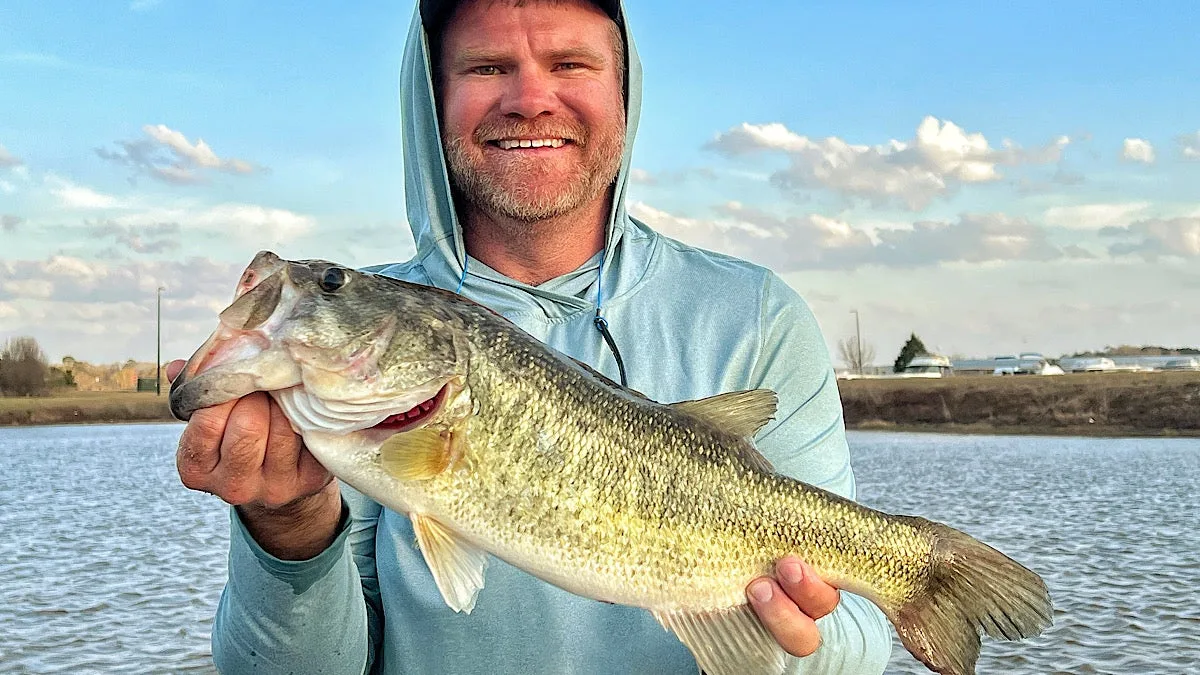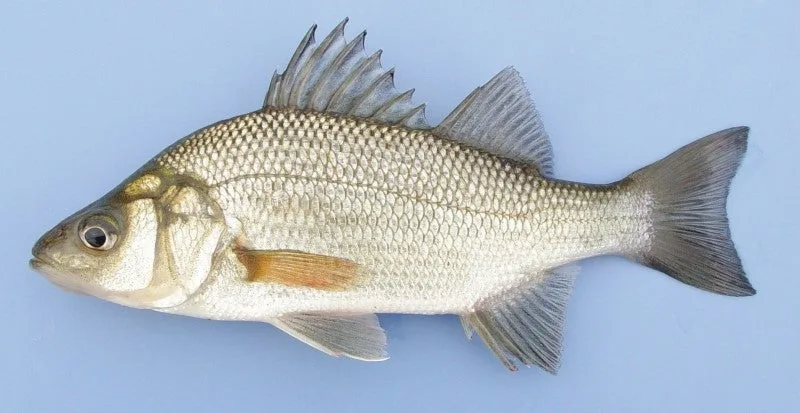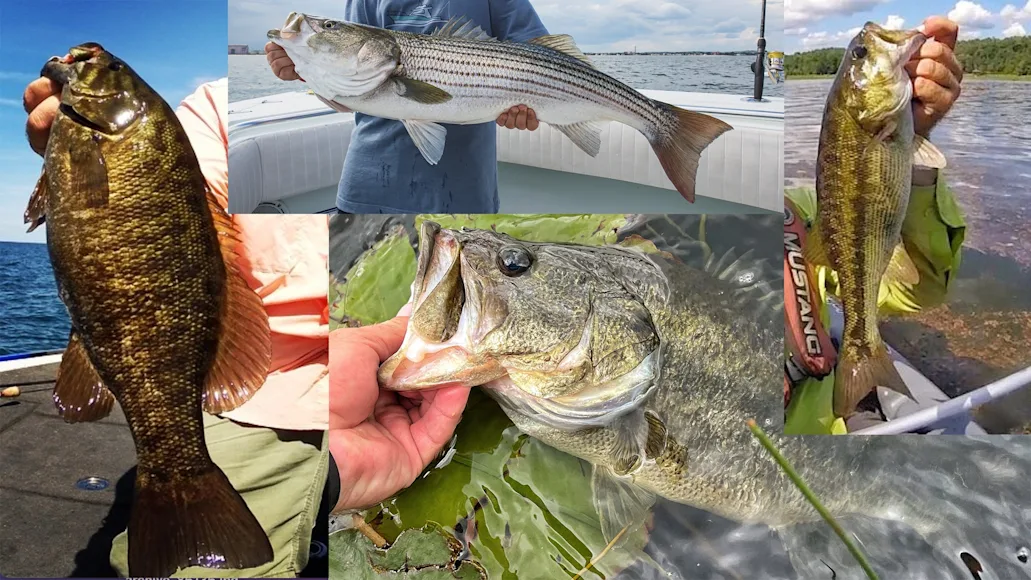If you asked the average American angler to name all the different types of bass, a handful of species would roll off the tongue, starting with largemouths and smallmouths, then probably stripers, and maybe spotted and white bass. But in fact, there are more than 20 different types of bass, some of which are not even called by that name. So, when someone says they’re going bass fishing, what they mean can be very different depending on where they live and whether they’re fishing fresh water or salt.
Truth is, when talking about the different types of bass, the conversation quickly become confusing and even a little overwhelming. So let’s simplify and break it down. Here are the key types of bass that matter most to fishermen.
Types of Black Bass

A particularly dark-colored largemouth bass. Shaye Baker
For starters, you should know that there are two main types of bass: black bass and temperate bass, with the former being the one most anglers are familiar with. As a group, black bass are by far the most sought after, found primarily in freshwater rivers, ponds, and lakes. Depending on which expert you ask, there are between 9 and 13 distinct species in this category, including largemouth, smallmouth, spotted, Alabama Bass, Suwannee Bass, Shoal Bass, Guadalupe Bass, Florida Bass, and Redeye Bass.
That said, largemouth, smallmouth, and spotted bass are easily the most common species across the U.S. and Canada, targeted by competitive anglers, trophy hunters, and recreational fishermen alike in lakes, rivers, creeks, and ponds. Therefore, we’ll focus on these black bass species and give each a little extra space below.
Largemouth Bass

The author with a lighter-colored largemouth.
The largemouth is the most common of all types of black bass, aptly named for its most distinguishing characteristic when compared to spotted and smallmouth bass. A big bucket mouth, however, isn’t the only way to identify this species. Largemouths typically have less-defined scale patterns, with large blotches along their sides as opposed to a line of defined spots (on spotted bass) or vertical bars (on the smallmouth).
Depending on water clarity, cover, and amount of sunlight, largemouth bass can range in color from pale (almost white) to dark green (almost black). These bass are aggressive feedings in low-pressure and low-light situations, so they can be targeted most effectively early and late in the day, and when a cold front or storm front is approaching an area.
Though largemough bass can live in deeper water in summer and winter, they thrive in shallow water throughout spring and fall and can survive shallow water year round. They are also more comfortable without current, as compared to the smallmouth and spotted bass. This is why the largemouth bass is the main type of bass found in shallow ponds.
Artificial lures and live bait both work well on this species of bass. Depending on the water temperature, depth, clarity and time of day, top baits include: squarebills, lipless crankbaits, Texas-rigged soft plastics, spinnerbaits, buzzbaits, flipping jigs, swim jigs, and frogs.
Spotted Bass

The author with a spotted bass Shaye Baker
Compared to largemouths, spotted bass thrive in deeper water and/or moving water. For this reason, you’ll often find these bass tucked behind current breaks in rivers and creeks or either offshore in lakes or near dams where current is generated.
As their name implies, spotted bass typically have more small spots scattered along their body than do largemouths or smallmouths, and the main line along the side of the bass has more defined patches of darker scales than on a largemouth, but these do not extend as high on the body as on smallmouths.
Of all the types of bass, the spotted bass is among the most ferocious fighters, testing the equipment and skill level of any angler that ties into one. They can be targeted with live bait or artificial lures. Some of the most effective lures and presentations for this type of bass are shaky heads, dropshots, jerkbaits, Ned rigs, Carolina rigs, spinnerbaits, and topwaters.
Smallmouth Bass

The author with a pair of big smallmouths. Notice the vertical barring on the fish’s sides. Shaye Baker
Smallmouths can thrive in still water or strong current, shallow or deep, but they don’t do well in warm water. For this reason, smallmouth bass are less prevalent below the Mason-Dixon line and are among the most targeted game fish in the northern U.S. and Canada.
This type of bass is best known for its brown or bronze color, hence the nickname “bronzeback.” The patterns on the sides of smallmouths show more vertical bars compared to the blotches on a largemouth and the spots on spotted bass.
Smallmouth do well in deep or shallow water and tend to spawn deeper than any other type of black bass, regularly up to 20 feet deep. Because most of these fish live in colder climates (often on fisheries that prohibit fishing for them during the spawn), the late summer and early fall are often the best times of year to target them.
Smallmouth bass are more visual feeders than largemouth and spotted bass, so they’ll travel greater distances on clear fisheries to attack a bait. For the that reason, jerkbaits, topwaters, and spinnerbaits work especially well. That said, when smallies are relating to the bottom, finesse baits like dropshots and Ned rigs work really well too..
Types of Temperate Bass
These bass live in both salt and fresh water, mostly along the east coast of the United States. Here are the four types of temperate bass most frequently targeted by anglers.
Striped Bass

A happy young fisherman with a nice striper. Adobe Stock
Stripers, as they are often called, are among the most popular saltwater gamefish and have been successfully introduced into a number of freshwater lakes and reservoirs, as well. They can grow to more than a hundred pounds and lengths of more than 5 feet, but any striped bass pushing 40 pounds is a monster.
White Bass
White bass look like juvenile stripers in many ways, but they don’t grow nearly as big. Their bodies are typically taller proportionately than that of the more elongated striped bass. Since these fish need current reproduce, they are often found below dams.
Yellow Bass
Of the four main varieties of temperate bass, yellow bass are the smallest. These fish are not reliant on moving water to spawn, like other temperate bass, and are therefore found in a wider range of fisheries.
White Perch

White perch. Connecticut Department of Energy and Environmental Protection
When fish names were handed out, the white perch was somehow mislabeled. They are, in fact, not perch at all but temperate bass—however, they are unlike other temperate bass in that they do not have stripes on their flanks.
Types of Hybrid Bass and Other Variations
There are several lesser-known species of bass as well as the occasional hybrid, whether created in a controlled environment or born in nature. The hybrid striped bass for instance was first produced by researchers in South Carolina in the 1960s when they mixed the eggs of a female striped bass with the sperm of a male white bass.
The meanmouth bass, which is a natural cross between a smallmouth bass and an Alabama Bass, can be found in several fisheries across the US. With variations and hybrid bass scattered across North America and often isolated to small areas, it’s impossible to know exactly how many types of bass there really are. But from and angling standpoint, if you know the types of bass listed above, you’ll have a solid handle on things.


